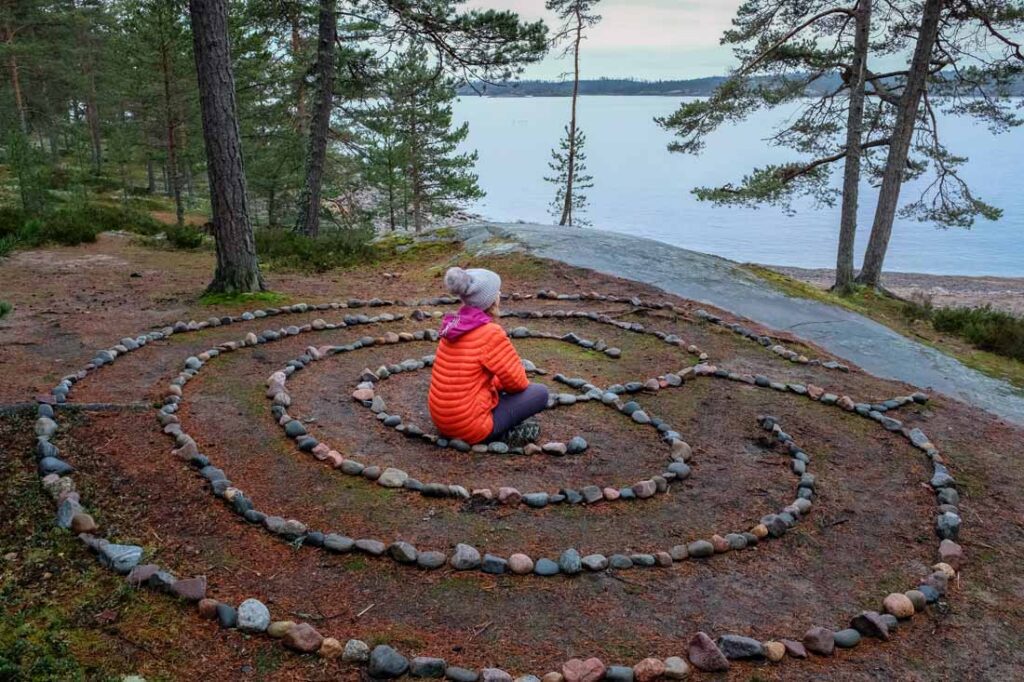Imagine stepping into your backyard to find the perfect reprieve from the daily stress of work and life. Since the pandemic, backyards have become the go-to spot for rest, relaxation and rejuvenation as more homeowners install spa-like amenities including hot tubs, plunge pools, yoga platforms and meditation gardens. One of the most unique relaxation tools to add to a yard is a labyrinth for walking meditation. Often found at houses of worship, luxury spas and community centers, meditation labyrinths are now being installed right at home.
According to Stephen Shibley, land artist at Fertile Ground, a studio specializing in labyrinth design and construction, residential labyrinths continue to grow in interest.
“Since COVID-19, many people have emerged from an inward time of retreat and loss to reevaluate what is really important,” he notes. “The trend of nurturing a better work-life balance and making more time for family, friends and self-care will continue to highlight the ways a home labyrinth can reinforce the benefits of embracing life’s unexpected twists and turns.”
What is a meditation labyrinth?
Dating back about 4,000 years in a variety of cultures around the world, labyrinths are circular or spiral paths that have a single route leading in and out of the center. Unlike a maze that requires finding a way out, there are no tricks to a labyrinth and no dead ends. From a spiritual standpoint, some people believe that a labyrinth represents the journey to the inner self.
Labyrinths are primarily used for mindful walking, a calming practice that allows users to focus on the present moment by tuning into the body’s sensations. Labyrinth walking meditation can be done barefoot or while wearing shoes, with the goal of moving slowly and being aware of each step and breath, without having a destination in mind. This rhythmic movement of lifting each foot slowly and purposefully, while also taking in the natural environment with all five senses, can help people reach a mindful state.
Benefits of labyrinth meditation
Spending time walking a labyrinth can boost well-being. A recent study found that people reported positive emotions, sensations and thoughts during and after labyrinth walking.
According to M.E. (Beth) Langley, a Veriditas certified labyrinth facilitator at Lasting Labyrinths, “Whenever you need a tool for your mind, body and spirit to use in appropriate and meaningful ways, look to the labyrinth. You can restore, activate and exercise your spirit, your body and your mind, all in one place, and become empowered and prepared for living well.”
Labyrinths provide a specific space and time for a personal meditative experience. “This is where a person can step outside of the frenzied world and walk in a contemplative way with an inner focus,” explains Lisa Gidlow Moriarty, labyrinth designer and master labyrinth maker at Paths of Peace. “We don’t often allow ourselves time to be quiet, but when we do, the experience can be refreshing, healing and calming.”

Moriarty also refers to the physiological benefits of using a labyrinth. “There appears to be a balancing effect that occurs when walking a labyrinth, in that one experiences the same number of 180-degree turns to the right and to the left, which seems to balance the body [and] the hemispheres of the brain, resulting in a deeper sense of calm.”
Finally, Anne-Marie Emanuelli, Veriditas certified labyrinth facilitator at Mindful Frontiers LLC, describes labyrinth walking meditation as a journey to the heart. “It is a release of cooped-up energy or energy that needs healing. Since the path leads inward to a center, it may feel as if the person walking is going toward their heart center.”
People walk the labyrinth for a multitude of reasons including grief therapy, personal meditation or simply to enjoy the picturesque space outdoors.
How to build a meditation labyrinth: Installation considerations
For those interested in installing a labyrinth on their property, there are many options and considerations to keep in mind. “There are hundreds of labyrinth designs and many ways to construct labyrinths,” Moriarty says. “An outdoor labyrinth can be as simple as mowing a design into the lawn or placing stones on the ground. Yet, it can be as complex as creating a design on concrete or with pavers.”
The size of the available space and the budget will determine what is possible. The cost to design and construct a labyrinth can range from zero dollars (for a simple DIY project) to $60,000 or more, depending on materials, size and design.
Moriarty suggests visiting as many labyrinths as possible before deciding on the details. Check out the Labyrinth Locator website to search for examples by location.
Labyrinth size and shape
Choosing the size and shape of a labyrinth is a personal preference. Shibley explains that people are often drawn to a particular pattern. “Sometimes the site’s opportunities and constraints may dictate a particular scale and orientation which then informs the pattern.” He suggests keeping residential labyrinths between 15 feet and 40 feet in diameter; ideally, 25 feet by 25 feet is the minimum space to nest a labyrinth. The most common patterns are the classical and medieval, with many variations based on shape and number of circuits. There are also many possibilities with contemporary designs.
Labyrinth materials
Choosing the best materials for a labyrinth project can vary depending on preference, budget, availability and even climate. Labyrinths can be built on new or existing concrete or asphalt or made using concrete pavers, bricks or natural stone. The path can also consist of grass, ground cover, mulch or compacted gravel. Another option is to use rocks, bricks and/or vegetation to delineate the pattern in contrast with the path surface.
Moriarty explains, “Materials vary greatly with location. If one lives in a desert environment, mowing a green lawn isn’t possible, but laying out the labyrinth with stones on the sandy ground would be.” Plus, deciding whether to walk on a soft surface like grass, a harder surface like wood chips or a solid surface is a consideration.
Labyrinth location
Shibley offers the best advice when it comes to where to place the labyrinth: “Put your labyrinth where you will see it. You will use it more and likely walk it with your mind’s eye, even if you physically can’t walk it at that moment.”
Labyrinth maintenance
Before giving the green light, consider how much upkeep will be involved. “There is no such thing as a maintenance-free labyrinth,” Moriarty warns. “Different materials will require different kinds of maintenance, so that should be part of the initial planning discussion.” For example, a labyrinth created with flower beds will require regular gardening, grass will need weekly mowing and stones may require weed control and trimming.
Get help from a pro
For those looking to hire a professional to design and build the labyrinth, be sure to choose a labyrinth expert, since most landscapers and general building contractors do not have the knowledge and experience to execute this type of project. Refer to the Labyrinth Society for a list of labyrinth specialists.
When working with a pro, expect a site visit and an initial consultation, which can be done virtually or in person. Then, a proposed scope of services will be shared.
“I most often recommend a conceptual master planning phase that allows me, the land artist, and the client to solidify the vision on paper so that we can best estimate the costs based on unique site opportunities and constraints, as well as client wishes for scale, pattern and type of material needed to build the labyrinth,” Shibley explains.
Build your own meditation labyrinth
Some homeowners may prefer to go the DIY route. Just be prepared for some challenging physical work. Emanuelli created a 30-foot, seven-circuit classical labyrinth at her New Mexico home. “Building a labyrinth is a creative and fulfilling activity,” she says. “It has been a blessing and a spiritual experience.”
To outline the path, she used rocks collected along walks she took over the years, and the path is covered with coarse sand. “I would advise to try not to build something that will cost a lot of money and take a ton of time,” she says. “My labyrinth is quite manageable, but it is amazing how much upkeep an outdoor labyrinth in a natural setting requires.”
How to make the most of your labyrinth
Once the meditation labyrinth is built, there are many ways to enjoy all of the positive aspects it provides. Moriarty suggests setting an intention for the labyrinth walk and having a thought, image, blessing, prayer or concern in mind while meandering. “Or simply walk with an open heart and quiet mind,” she says. “Above all, let go of the distractions, the nagging ‘shoulds’ or to-do lists, and give yourself the gift of quiet time. Let whatever feels important arise, and let go of anything that seems to be a disruption.”
Other ways to engage with the labyrinth include listening to relaxing music or recorded nature sounds or choosing a peaceful word or phrase as a mantra to repeat while walking the path. Some ideas include “I am peaceful,” “I feel happy,” “Om,” or “this too shall pass.” Finally, capture the essence of the experience afterward by journaling, writing poetry, drawing or painting about thoughts and feelings that may have arisen during your time in the labyrinth.
Photo by Lana Kray/Shutterstock.com



